| Electrical Circuits - Analytical Methods |
Considering Current Sources
Now consider what happens when a
current source is connected to a node. You might
suspect that this situation is the most complex of all, but, in fact, it is one
of the simpler ones. In the example below the current source is deliberately
set so that the current is actually flowing into the node if
Is is positive. Now, consider
writing the current equations for this circuit.
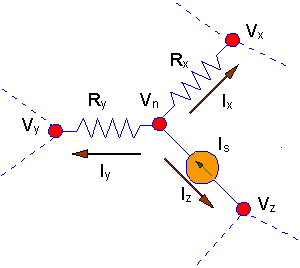
Ix +Iy
+ Iz = 0
becomes:
(Vn -Vx)/Rx
+ (Vn -Vy)/Ry - Is
= 0
Given all of the
above, there is one last question. That is, "How
many independent equations result when KCL is written at all of the nodes?",
Consider the following:
- Assume that the circuit
is composed of resistors, voltage sources and current sources. Assume that
the circuit hasn + 1 nodes.
- One of the nodes in the
circuit must be chosen as areference.
Usually, if there is anode connected to ground,
then that will be the reference.
- Otherwise, choose any
other node as the reference.
- All
other node voltages will be measured from the voltage at the reference node.
That reduces the number of voltages that must be found from
n + 1 to
n.
- Every other node voltage is
potentially an unknown voltage that must be found - n node voltages in all.
- If there is a
grounded voltage source,
then one node voltage is determined by that voltage source - at the
ungrounded end of the voltage source.
- Every grounded
voltage source reduces the number of unknown node voltages by one. If
there arenVg
grounded voltage sources, that reduces the number of unknown node
voltages bynVg
ton - nVg.
- If there are
ungrounded voltage sources,
then those ungrounded sources fix the difference in voltage between two
nodes. Essentially, if you know one of those node voltages, you can compute
the other. Thus, each ungrounded voltage source also reduces the number of
unknown node voltages by one.
- If there are
current sources in the
network, theyhave no effect
on the number of unknown node voltages, although it will most definitely
have an effect on the value of node voltages in the network.
- Thus, the number of
node equations isn - nV,
wherenV
is the number of voltage sources in the network.
- You get those equations by
writing KCL at every node not connected to a voltage source (grounded or
ungrounded) and one of the nodes connected to every ungrounded voltage
source.
After writing the node
equations, the next problem is to put them in a form that is easier to solve,
and that is the next thing you have to consider.
Getting A Set Of
Simultaneous Equations
Once the KCL equations are written for a
network, the next step is to cast the equations into a form amenable to
solution. The form you should be looking for is a set of simultaneous linear
equations. In other words, you are looking for something like the following:
a*x + b*y + c*z = j
d*x + e*y + f*z = k
g*x + h* y + i*z = l
This is a standard form for simultaneous linear
equations, and for circuit equations the variables (x, y and z) would probably
be node voltages (e.g. Vx, Vy and Vz).
Considere a typical node voltage equation
(taken from earlier in this lesson):
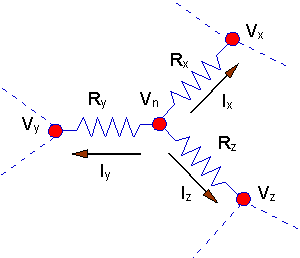
(Vn -Vx)/Rx
+ (Vn -Vy)/Ry + (Vn
-Vz)/Rz = 0
Separate all of the terms that involve Vx,
etc. and combine, and the result is:
(1/Rx + 1/Ry
+ 1/Rz)Vn - Vx/Rx
- Vy/Ry - Vz/Rz
= 0
And this is the form we want. This particular
equation has four unknown node voltages, but that would be the case for the node
shown just above.
Similar equations occur for the other
possibilities.
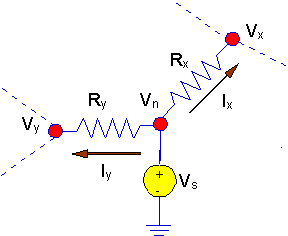
If there is a grounded voltage source, no KCL
equation is written at that node because the node voltage is known:
Vn = Vs
If there is an ungrounded voltage
source, there is one less KCL equation.
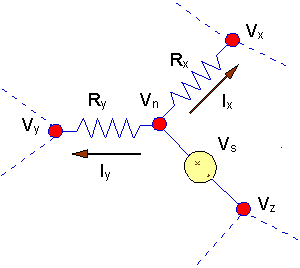 Here there are two possibilities.
Here there are two possibilities.
We could write:
Vn = Vs
+ Vz
Then we would write a KCL
equation at node "z" that included Ix
and Iy flowing away from node
"z'. Here is an example to illustrate the point.
Example
E1
In this circuit, note the following:
- The voltage at node "x" is
known:
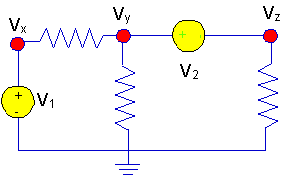
- We can select either
node "y" or node "z" as the node with the unknown voltage. Select one, and
the other is determined. We will take Vy
as the unknown voltage, so:
- We can write KCL at
node "y". Actually, it may be better to think of a
supernode that includes
both node "y" and node "z". The green shading shows the supernode. The sum
of the currents leaving the supernode must sum to zero - for the same reason
that the sum of the currents leaving a node sum to zero - conservation of
charge!
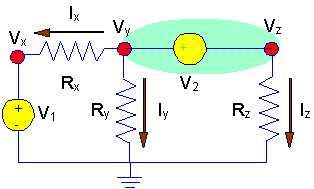 Write the KCL equations for
the entire super node:
Ix + Iy
+ Iz = 0
Then, note that:
Ix = (Vy
-Vx)/Rx
Write the KCL equations for
the entire super node:
Ix + Iy
+ Iz = 0
Then, note that:
Ix = (Vy
-Vx)/Rx
Iy = Vy
/ Ry
Iz = Vz
/ Rz= (Vy - V2)/ Rz
And the KCL equation for the
supernode becomes:
(Vy -Vx)/Rx
+ Vy / Ry + (Vy - V2)/
Rz = 0
And, for this circuit that
is the one independent KCL equation that can be written (unless you choose to
keep Vz
as your unknown, but there is still only one equation.) That means writing this
in the standard form, we would have:
(1/Rx + 1
/ Ry + 1/ Rz)Vy - Vx/Rx
= V2/ Rz
The coefficient of
Vy is the
sum of the conductances connected to the supernode, the source appears on the
right hand side, and the negative reciprocal of the shared resistor shows up
just where we might expect it.
|

